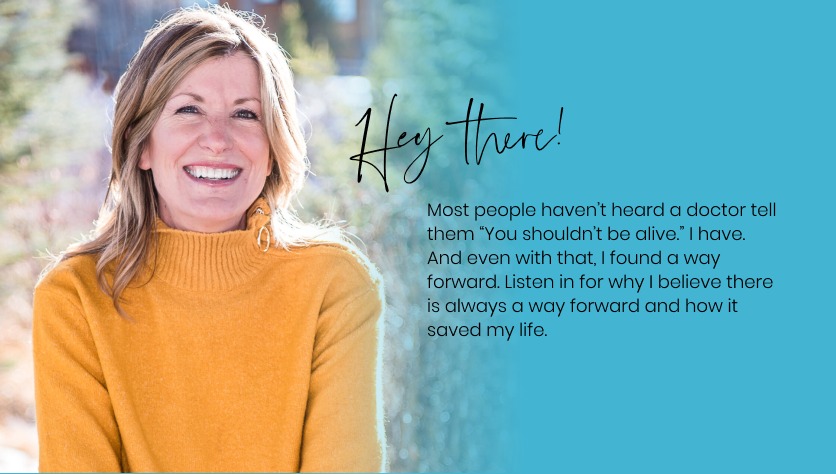Today I want to share a powerful mindset that you can use that will keep you calm, clear-headed, able to see more options for yourself and moving forward.
It is a mindset that has served me very well under a variety of situations.
Here are a few examples:
When a doctor told me in 2003 that only 3% of people who had the illness that I had would experience a full recovery, it kept me motivated and moving forward, and, ultimately led to my recovery and even to becoming healthier, stronger and more fit than before I got sick.
When I was part of a team that was delivering training at Fortune 100 company’s annual sales meeting, I was thrown a massive curve ball 12 minutes before I was suppose to begin my 2-day session. Our instructional design team had met with the client and had put together the program based on what they had learned. It was a good program and I was prepared. I had put together my examples based on what I had learned from our instructional design team. Then, with 12 minutes to go before the session began, the leader for the team that I was to train, introduced herself and said, “Hey I wanted to introduce myself and tell you a bit about our team because no one here internally at our company or from your company talked to me about this team. We are a bit unique within this company.” That turned out to be a massive understatement. About 80% of what had been put together wasn’t relevant to this team. Every example I had prepared was meaningless.
I had 12 minutes to figure it out. And, I did. At the end of the session, nearly every person in the room shook my hand and said that it was the most relevant training they’d ever had.
So, what is the superpower mindset?
It’s very simple: Assume that there is a way forward. Even if you don’t know what it is. Believe there is a way forward.
This does two very important things:
1. It keeps us from going into a panic state, which keeps our brains calmer and more open to seeing options that we wouldn’t – actually couldn’t see – if we are in a panicked or stressed state. When we are in a stressed state, we literally cannot see options, and we are shutting off the part of the brain where creativity and problem solving exist.
Every time I think of this I think of football and quarterbacks. If you think about the greatest quarterbacks, when they drop back to pass and the pocket collapses and they are being chased by the defense, they still remain calm and are still scanning the field for the best play they can make, and they often see the receiver who manages to break free from his defender for a nice completion. These QBs are frustrating for defenses because even if you pressure them, they rarely make big mistakes or turn the ball over.
Contrast that to other quarterbacks, who the second the play breaks down and there’s any sort of pressure, they start scrambling and running for their lives and they can’t see the open receiver down the field. Worse, they make mistakes that hurt the team.
I’ve watched a lot of football over the years, and often the difference in the success of a quarterback isn’t just arm strength – it’s the ability to stay calm, assess options and make good decisions under pressure.
2. The second thing that this mindset of believing that there is a way forward does for us is related to the first but is slightly different. The first one is that by keeping us from getting hijacked by stress, panic or pressure, we can see more options, be more creative and be better problem-solvers. This second one is that when we believe that there is a way forward, it activates our brain to actively start looking for more options. We are programming it to look for options.
Think about it this way: if we say to ourselves, there’s nothing that I can do about this, we’ve ended the conversation. We aren’t looking for new solutions or options, we are instead focused on the “fact” that there’s nothing we can do. This has been proven time and time again.
Going back to my examples earlier. When the doctor told me that roughly only 3% of people who had the illness I had would experience a full recovery, I thought, “Okay. I need to find those 3% or the doctors who treated them because someone has the answer.” It kept me going, it kept us searching for answers – and we eventually found one of those doctors.
In the training example I shared where 12 minutes before I was to begin, I learned that 80% of what I was about to share would not be relevant for the team, I remember thinking, well, I might have initially said a curse word in my head and then I thought: “Okay. You’ve trained a lot of different teams, let’s learn more about the challenges facing this team and let’s go from there. There’s a way to deliver the value that they need.” Once I had that thought, it immediately came to me how I could set it up to learn more about their situation and challenges and then connect it to other programs I had taught over the years. I began the program on time and completely confident that we would be able to move forward together, and they’d get great value.
Here is how you can use this the next time you are facing pressure, deadlines, or challenges:
Begin by saying to yourself: I know there is a way forward. There is a solution.
If others are involved, share that with them as well. Also, it’s helpful to share that it’s okay if right now, in this moment, you don’t have the solution or answer. The important thing is to remember that the answer is somewhere. Together you will find it.
What can get in the way?
I want to add that this is sometimes hard for leaders and managers (and maybe parents and teachers) because these are roles where you feel like you “have to have the answers.” I get that. I’ve seen it hundreds of times with the managers that I’ve coached over the years.
I faced this myself. There was a time in my life, where I always felt like “I have to have the answer!” Which, when you think about it is kind of silly. If there is a new challenge or new opportunity or new whatever in front of me, then how could I have the answer if the situation is new? Instead, I started to intentionally – and with a lot of effort – shift from: “I have to have the answer” to “I want to find the answer.” It took away pressure and what do you know? It helped me relax, not get caught up in the pressure and the answer became easier to find.
Another breakthrough with this came related to coaching. In coaching, there is a framework that the answer is somewhere. And coaching is a process of discovering the answer. I knew that and believed in it. Then I experienced it.
I was doing a year-long master coaching program, where 5 managers were becoming master coaches for their teams. My role was to be their coach and lead them through that process.
After the program was complete, they reached out to me and said, “We have been given a new directive and we are really stuck, and we’d love to talk to you because we know that you’ll have the answer.”
We jumped on a conference call, and they were sharing the situation and I kept hearing the words: “we know you’ll have the answer,” over and over again. And, frankly, I was thinking, “I have no idea what the answer is!” But then I remembered, “The answer is somewhere.” I immediately relaxed and I started deeply listening. At the appropriate point in the conversation, I gave a re-cap as to what seemed most important and what they needed to solve. Then I said, “Okay, we are working from the standpoint of “The answer is somewhere. What are the different ways we can find it?” Within 15 minutes, THEY came up with a solution that they all believed in and ultimately it worked for them. They actually didn’t need me to have the answer; they needed me to hold the space for the answer to emerge.
That experience sold me on how valuable it is to let go of my attachment to having the answer and to stay committed to holding the space for the answer to emerge.
That’s what my goal is in this episode: I want to hold the space for you that whatever pressure, challenge, or situation that is in front of you right now, the answer is somewhere, there is a way forward, and I believe in you and your ability to find it.
Have a great week, be well and I’ll be back again in a few days!








